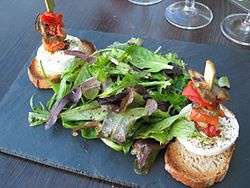Mesclun
 | |
| Type | Salad |
|---|---|
| Place of origin | France |
| Region or state | Provence |
| Main ingredients | Chervil, arugula, leafy lettuces, endive, chive |
|
| |
Mesclun (French pronunciation: [mɛsˈklœ̃]) is a salad mix of assorted small, young salad green leaves, which originated in Provence, France. The traditional mix usually includes chervil, arugula, leafy lettuces and endive, while the term may also refer to an undetermined mix of fresh and available baby salad greens,[1] which may include lettuces, spinach, arugula (rocket, or roquette), Swiss chard (silver beet), mustard, endive, dandelion, frisée, mizuna, mâche (lamb's lettuce), radicchio, sorrel, or other leaf vegetables.
The name comes from the Provençal, mesclum, derived from the verb mesclar, to "mix thoroughly," and literally means, "mixture."[2] According to the Merriam-Webster Dictionary, the term was first used in 1976.[1] According to local lore, mesclun originated with the farmers around Nice, who would each bring their own unique and prized mix of baby greens to the farmers' markets; one of the most representative and authentic versions is a combination of baby dandelion, lettuce and arugula.[3]
Noted chef Alice Waters comments, "Outdoor markets in Provence display mesclun in profusion, a melange of the first tender young leaves which appear in the garden. Mesclun can be an extraordinary lettuce mixture: rocket, much like the rugola (arugula) found in Italian markets; chervil; mâche, or lamb's lettuce; and oak leaf. On occasion, baby curly endive (chicory) or young dandelion greens find their way into the medley, depending solely upon the grower's personal preferences combined with the reality of whatever else might send up shoots in the spot where mesclun grows."[4]
In the North American foodservice industry, the first appearance of mesclun is traced back to restaurants and farm stands in the early 1980s, with a rise in popularity since. A mesclun mix is described as comprising baby leaves of lettuces and other greens, and often herbs, in a wide range of leaf shapes, colors, textures, and tastes. Depending on the season, a mix might contain anywhere from a dozen to three dozen different types and varieties of baby greens, including red and green oak leaf, romaine, and lolla rossa lettuces, frisée, tatsoi, bok choy, arugula, spinach, orach, mizuna, dandelion, mustard, and cress. When available, locally grown, direct-from-the-farmer sourcing is recommended over commercial bulk packs for best flavor and freshness.[5] This version of mesclun, sometimes considered an evolution, is also known as spring mix.[6]
Mass production
Meslum can be an interesting and tasty mix handcrafted by a farmer or chef, or a generic "spring mix" composed of cut up lettuce and other greens mass-produced by a large agribusiness and distributed nationally. Quality varies widely.[7]
References
- 1 2 "mesclun". Merriam-Webster. Retrieved 17 March 2015.
- ↑ "mesclun". Oxford Dictionaries (Oxford University Press). Retrieved 22 March 2015.
- ↑ Davis, Hillary (2013). Cuisine Nicoise: Sun-kissed Cooking from the French Riviera. Gibbs Smith. p. 79. ISBN 978-1-4236-3294-8.
- ↑ Waters, Alice (1995). Chez Panisse Menu Cookbook. Random House. ISBN 9780679758181.
- ↑ Brad Matthews; Paul Wigsten (2011). Kitchen Pro Series: Guide to Produce Identification, Fabrication and Utilization. Culinary Institute of America (Delmar/Cenage Learning). p. 25. ISBN 9781435401211.
- ↑ Fromartz, Samuel (2007). Organic, Inc.: Natural Foods and How They Grew. Houghton Mifflin Harcourt. pp. 118–138. ISBN 0156032422.
- ↑ "Eating Well: Old Lettuce Masquerades As Mesclun" - New York Times, June 26, 1996